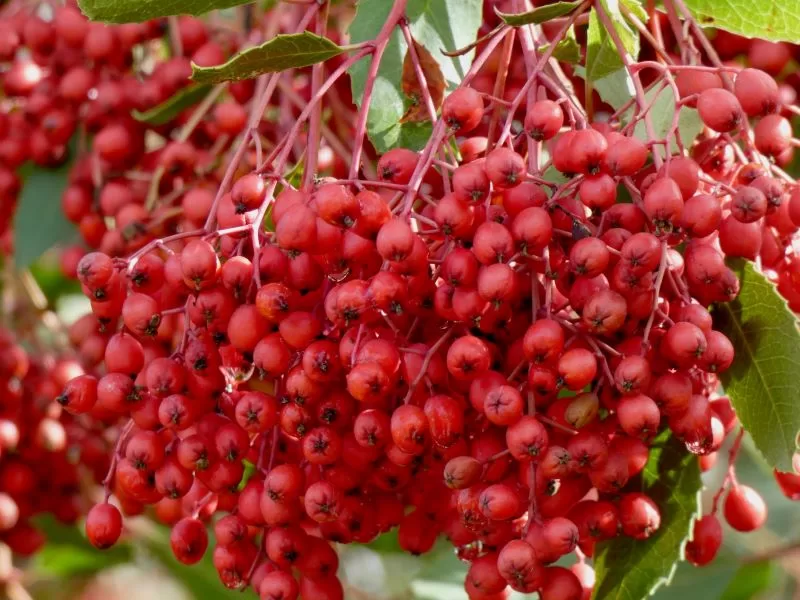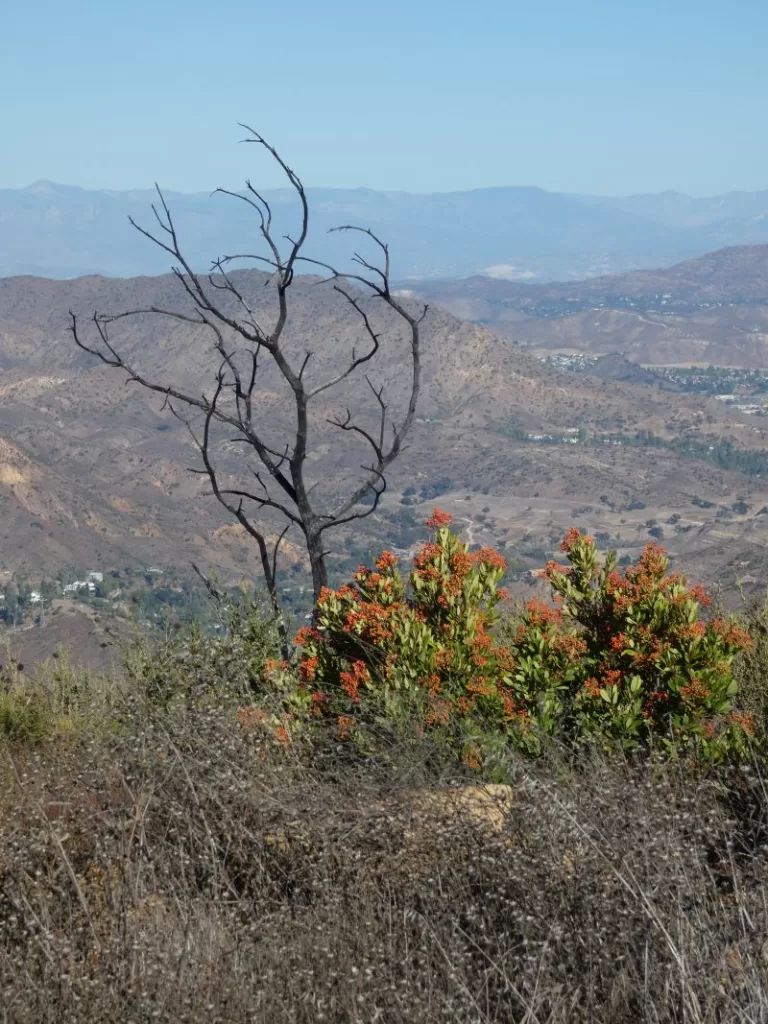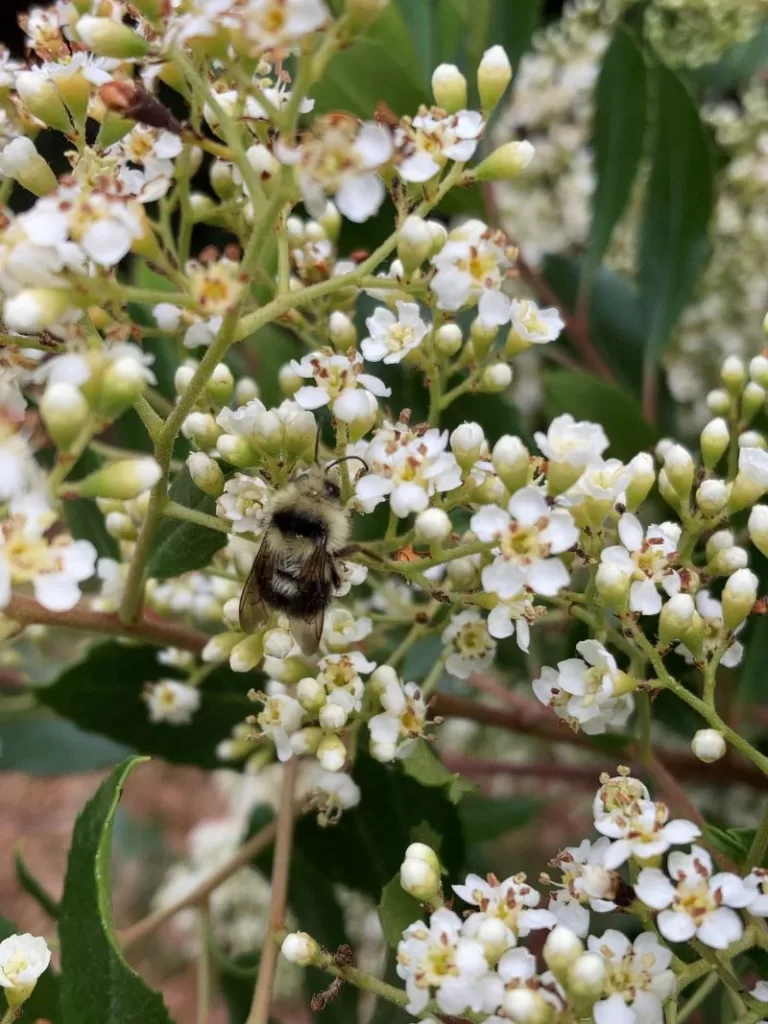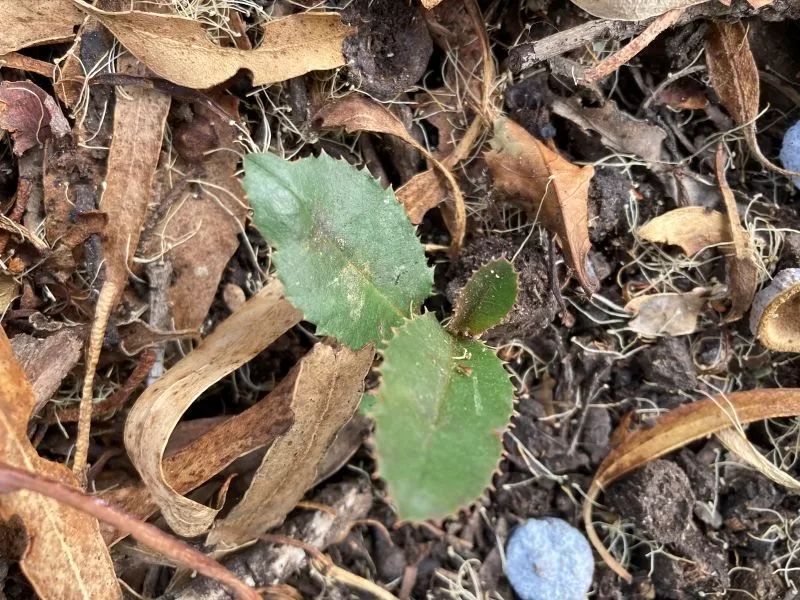
All over Topanga Canyon and throughout the Santa Monica Mountains, toyon bushes are ablaze with red fruit. Their presence is both a conservation success story and a cautionary tale, because the toyon’s beautiful red berries, so like European holly berries in appearance, caused the toyon to be pushed to the edge of extinction just a hundred years ago.
Because it fruits in midwinter, toyon is also known as Christmas berry and California holly, but it isn’t related to the European holly, despite some superficial similarities. Instead, toyon is a member of the rose family. It’s the only species in the genus Heteromeles.
The word “toyon” is said to be derived from the Ohlone word “totcon,” making it a rare plant that retains its native American name. It’s endemic to the West Coast, growing abundantly in the coast ranges of California.
Many Indigenous cultures, including the Chumash, ate the fruit, which is tart, slightly bitter, and only edible when foully ripe. They also used the leaves and bark for medicinal purposes—with care, because these parts of the toyon can be toxic. Toyon wood is hard and can be tempered with fire to make it harder. It was an ideal choice for making tools and weapons like arrows.This tough and beautiful shrub has evolved to survive drought and fire. Its deep roots help anchor the soil on steep canyon slopes, and help it to recover quickly after fire, regrowing from the root crown.


This is one of the most abundant chaparral plants in the Santa Monica Mountains. The toyon’s abundant clusters of small lacy flowers are an important source of nectar for native pollinators. Its vivid red berries are a critically important food source for migratory birds like the cedar waxwing and the American robin, and are also a food source for a wide range of animals, including coyotes. Unfortunately, the berries also attract humans. A craze for using the berries for holiday decorations took a major toll on the species statewide in the early years of the twentieth century.

The earliest written account of Christmas in the Santa Monica Mountains appears to be one published by Frederick Hastings Rindge in his 1895 book, Happy Days in Southern California.
Rindge, who purchased the entire 13,500-acre Topanga, Malibu, Sequit Rancho—now the city of Malibu—in 1892, describes his house festively decorated with boughs and wreaths of toyon berry and the air of holiday anticipation within the walls of a household with young children in it.
Rindge was a wealthy man and toyon was abundant on his private ranch, but the brightly colored berries became a lucrative sideline for less wealthy residents of the Santa Monica Mountains. Toyon berries sold for around 25 cents a pound in the 1920s. Good money for homesteaders who struggled to make ends meet. In Topanga Canyon, enterprising homesteaders jumped on the craze for toyon berry decorations and harvested and sold toyon together with the oak firewood they carted out of the canyon and into town.
The homesteaders soon had competition. The automobile enabled access to areas that would only a few years earlier have only been reached on foot or by horse. The impact was devastating.
On November 29, 1924, the Las Gatos Star reported, “Hundreds of acres of the shrubs are carefully harvested by wholesale florists each year, They are shipped to our cities by the carload, but that is not sufficient. Thousands upon thousands of people go out into the hills and gather the wild red berries for their own use. It has become one of our customs and traditions. Due to the ruthless methods of the hordes who gather these berries each year, these trees were being annihilated. They would cut down and break down trees, regardless of next year’s production of berries.”
Local governments struggled to pass ordinances protecting toyon. The California Automobile Club published pleas to its members and other motorists to leave toyon and other native plants alone. In March of 1921, the state senate approved a bill prohibiting any person from mutilating or destroy any toyon or any part thereof on public or private land without written permission, but the final law doesn’t seem to have been adopted until 1927, when CA Penal Code 384a was added to the law book. It includes a prohibition on collecting, cutting or harming native plants on state and county road rights-of-way.
By then, the fad for fresh toyon berries was almost over. The Oakland Tribune reported in 1925 that San Jose law enforcement officials were offering a $25 reward for information leading to the arrest of toyon rustlers—more than most rustlers would make harvesting wild berries. In 1929, a drought year with a scant harvest in addition to being the year the stock market collapsed, toyon berries were selling for just $40 a ton.
The law may have helped, but there may have been other factors: less money to spend on holiday decorations during the Depression; and a new fad for artificial decorations for those who could afford them; and then, the economic downturn occurred during a cycle of drought in the West, which would have meant fewer toyon berries available even for those who obtained them legally.
Toyons weather periods of drought by conserving resources and only produce abundant fruit in years with adequate rain. Toyon can live for more than a hundred years, possibly as much as two hundred when conditions are right. Some of the toyons Penal Code 384a was written to protect may still be alive and well, having survived the toyon berry craze and gone on to become a valued and protected California resource. In 2012, the toyon was named the City of Los Angeles’ official plant. One thing it isn’t is the source of the name “Hollywood.” That name was dreamed up by a developer and had nothing to do with toyon berries, despite urban legend.
Anyone aspiring to decorate their mantelpiece in the old time style should consider planting toyon in the garden, rather than harvesting it in the wild—toyon is still a protected species. Toyon is usually a medium-sized shrub but can grow to be a small tree. It rewards the gardener not only with vivid red berries but with an abundance of small lacy flowers in the spring that attract honeybees and native pollinators.
Look for the vibrant red berries throughout Topanga Canyon, but especially in the S curves along Topanga Canyon Blvd., where they grow in beautiful abundance.












